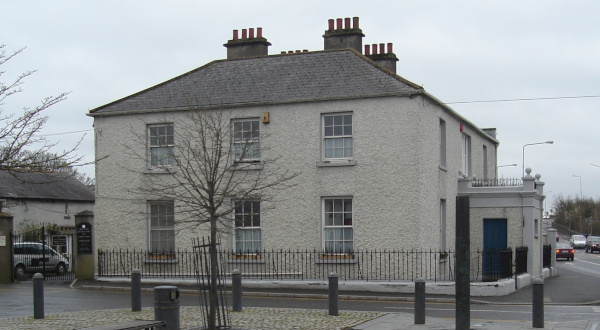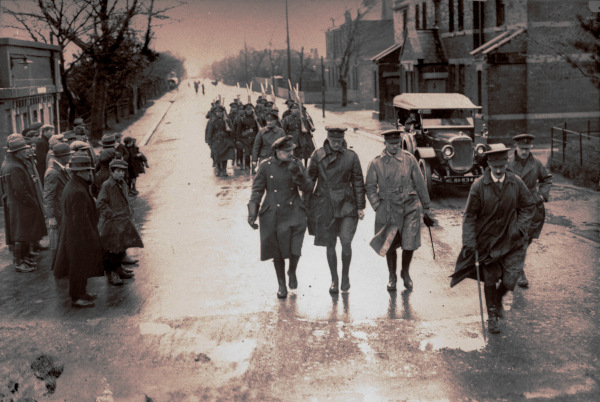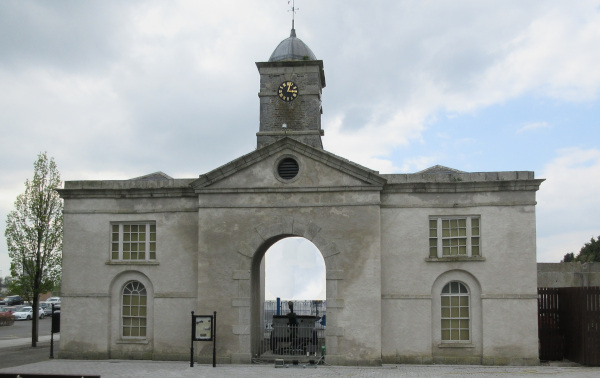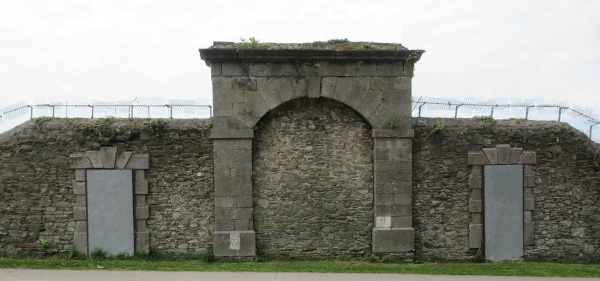Evacuation of British Security Forces
from Kildare, 1922
Published in the Liffey Champion, 7th May 2022
The departure of British security forces in 1922 – their Army, the RIC and the Black & Tans – was a momentous event in County Kildare. The handover to the new Irish Provisional Government of the Military and Police Barracks across the county took place between March and May 1922.
Preparation began in early January when the treaty had been approved by Dáil Éireann, the Commons and House of Lords in Westminster.
Four extensive British army stations extended across central Kildare; the military barracks at Naas and Newbridge, the artillery barracks in Kildare town and the Curragh Camp. The latter was the second largest in the United Kingdom. The RIC and Black & Tans – were barracked at Maynooth, Athy, Kildare, Newbridge and Naas, the latter being the Constabulary headquarters in the county.
RIC evacuation, March 1922
The British authorities decided that the police would be evacuated before the army. Athy RIC were withdrawn first on the 10th of March. Their barracks was then taken over by appointees of the IRA headquarters in Dublin; these included, Brigadier Police Officer Ryan, Commandant Tom Finn, Police Officer Farrelly and Hugh Eoin McNeill. In Maynooth, the barracks in Larine House in the town centre was handed over to Captain McKenna (IRA HQ) and Sean Kavanagh, County Kildare Liaison Officer. Newbridge was passed to Captain Joseph Rowan and local Irish Republican police deemed loyal to IRA HQ. Likewise, the Constabulary barracks in Kildare was given over to personnel approved by the IRA’s headquarters. The handover of Naas RIC Barracks on the 24th of March was the last and the most important. There had been fifty Black & Tans, stationed in Naas between the RIC’s HQ on the Main Street and the military barracks on the outskirts of the town. They were evacuated in late February.
The RIC in the Kildare were commanded by the County Inspector Murphy who had succeeded Mayor Scott and following the evacuation they were quartered in Hare Park, Curragh Camp, the demobilisation centre. The RIC barrack in Naas was handed over to Brigadier Thomas Lawler, who commanded the 7th Brigade of the pro-Treaty IRA. The local Company marched into the building and Lawler hoisted the tricolour.

Larine House, Maynooth RIC Barracks.
The changeover throughout the county went smoothly and low-key; only trusted pro-Treaty IRA personnel occupied the various barracks. Between January and March divisions in the IRA on account of the treaty widened, but the permanent split in the movement did not occur until the 26th of March. As a result, anti-Treaty IRA personnel including senior figures such as Tom Harris and Paddy Mullaney, who were at the forefront in the battle against the RIC during the War of Independence, were excluded from the change-over process. In Maynooth most of the IRA Company opposed the treaty. They had fought continuously against the RIC from 1916 to 1921 and contributed significantly to the departure of the British security forces. Growing infuriation on the anti-Treaty IRA side exacerbated the split which had serious consequences later that year.
Evacuation of Kildare Artillery barracks, 15th of April 1922
Preparing to evacuate the Army began about the 23rd of February when Richard Mulcahy, representing the Provisional Government, visited the Curragh Camp and held discussions with senior British army officials. A vast quantity of property and equipment had to be removed. Huts and military stores were sold by public auction. Officers’ personal property, including their houses and horses were sold.
Kildare artillery barracks was the first to go and the re-deployment of 1,800 men of the Royal Field Artillery on Saturday the 15th of April completed the task. The extensive military barracks was then occupied by 300 National army soldiers, supervised by Captain Cotter and Lieutenant Rowan who were appointed by IRA HQ. Most of these soldiers came from the National army camp based in the former Celbridge Workhouse; this was the first Irish army academy set up by the Provisional Government in January.
Handing Over the Curragh Camp, 16th of May 1921
The arrangements for transferring the Curragh, Newbridge, and Naas were handled by Lieutenant-Colonel Francis Elphinstone-Dalrymple for the British and by General Emmet Dalton, Chief Liaison Officer for the National army. The first property transferred at the Curragh was Ballyfair House, General Jeudwine’s residence; he was second in command of British troops in Ireland. It was handed over to General J.J. ‘Ginger’ O’Connell, Assistant Chief of Staff, of the National army, weeks before the evacuation. Lieutenant Liam Collins was put in charge of Ballyfair; it served as an assembly area for Irish troops destined to take over the Curragh Camp. As with Kildare military facilities, all ordnance and barrack stores belonging to the Royal Engineers and Royal Army Service Corps – about 1,000 tons – had to be moved to Britain and Northern Ireland. The Royal Scots Fusiliers left Hare Park on the 4th of April along with the remaining RIC. Certain civilian employees within the administration took charge of camp installations and stores. The fire-brigade, which was often of service to the local community, was withdrawn to Dublin. The bakery and abattoir were closed and caretakers installed; likewise, the Curragh Military Hospital. Patients fit to travel were transferred to King George V Hospital, (now St. Bricin’s) Dublin; those unfit were transferred later to Dublin or Kildare Infirmary. Records of the British army indicate that two personnel were still in the Curragh in June 1922, most likely patients in the Military Hospital.
On the morning of the 15th of May 1922, troops of the 30th Brigade Royal Horse Artillery, and 2nd Royal Welsh Fusiliers marched out to the Curragh siding and departed for Dublin. Later, an advance party of about eighty National army troops, commanded by Commandant Patrick Cronin, arrived by train from Beggars Bush Barracks, Dublin and settled in overnight in Hare Park. Among them were Captain Hugh McNally and Lieutenant Eamon Prendergast, both veterans of the War of Independence in Kildare. Later that night, they were joined by General O’Connell, Commandant David Bissette and Captain O’Byrne. To them were added the 100 troops then stationed at Ballyfair days earlier.
The British forces set out early the following morning on the 16th of May. By 9 am all roads from the camp were filled with lines of marching men and over 300 lorries and armoured cars, en route for Dublin. The infantry, composed principally of Leicestershire and Northamptonshire Regiments, proceeded to the railway siding. They were supervised by Commandant-Colonel Percy Skinner.
General O’Connell was appointed to take over the camp on behalf of the Provisional Government. At 10:30 am, at the head of his staff and advance party, he met Lieutenant-Colonel Elphinstone-Dalrymple and other British officers at the staff house. The two senior officers of each group proceeded to Beresford Barracks (now Ceannt Barracks) where the handover took place.

Irish and British army officers at the evacuation in the Curragh Camp. Courtesy, Military Archives, Dublin.
Elphinstone-Dalrymple attended by a military assistant then escorted O’Connell, who was accompanied by Commandant Bissette, around the south perimeter road for an inspection. This party were followed by Captain McNally of the National army. Behind him Lieutenant Prendergast led a unit of Irish soldiers who were armed with rifles and fixed bayonets.
Four of the personnel in the general group had Kildare connections General O’Connell and Commandant Bissette were educated in Clongowes Wood and Newbridge Colleges respectively while Captain McNally and Lieutenant Prendergast were from Monasterevin.
While this was taking place the second senior British army officer remaining in the camp, Lieutenant-Colonel Clifton Stockwell, escorted Commandant Cronin along the north perimeter road for a similar inspection. This wasn’t the first occasion that Colonel Stockwell engaged with a military adversary. During WW1 while serving as a captain in Flanders, he played the primary role together with German officer, Baron von Sinner, in the events of the famous Christmas Truce of 1914, which was portrayed in the 1983 song ‘Pipes of Peace’ by Paul McCartney.
As the British troops marched out, detachments of Irish troops arrived from Kildare and Newbridge train stations. A contingent led by Commandant Barra Ó Briain passed the last of the British column to leave the Curragh. Some in the British cavalcade took to catcalling. Ó Briain cautioned his men to keep calm. saying ‘if our positions were reversed we would feel the same way’.
As was the custom, the British removed the flagpoles before they left. It was not until 12 o’clock that a flagpole was obtained by the National army and the tricolour was hoisted by O’Connell over the water tower in the camp. Desmond Fitzgerald TD of the Publicity Department of Dáil Éireann and Commandant Cronin, the newly appointed Camp Commandant, were among those present.

Archway and clock tower of Naas Military Barracks in the grounds of Áras Cill Dara.

Archway entrance into Newbridge Cavalry Barracks, Athgarvan Rd, Newbridge.
Evacuation of Newbridge and Naas, 16th May 1921
Newbridge military quarters were also exchanged on the 16th of May with entry routes for the National army and exit routes for the British army agreed in advance. At 10:30 am, the barracks was formally taken over by the National army represented by Captain O’Kelly of the Irish Board of Works and Captain Joseph Rowan.
Naas Army Barracks, the former depot of the RDF – now the site of Árus Cill Dara – was the last to be vacated in the county. The same procedure was adopted with the Leicestershires marching out at noon. The depot was then taken over by Brigadier Thomas Lawler, Colonel-Commandant Moylan, and Captain John Joyce who was put in charge. Joyce had led the detachment of the National army from Celbridge Camp which occupied the barracks.
The arrival of Irish troops was generally welcomed in the evacuated barracks, however, there was a report of disgraceful behaviour by some soldiers travelling from Naas to the army camp at Celbridge on the 20th of May, days after the changeover. At a Kildare County Council meeting it was alleged when passing through Naas and Sallins, some appeared to be intoxicated and discharged shots in the air. Subsequently, Captain Joyce expressed deep regret for the incident indicating that some of the men involved were under arrest and disciplinary action had been taken. The evacuation of the Curragh Camp is often regarded as the most important event in the history of County Kildare, surpassing in importance the arrival from Britain of Strongbow and his men in the twelfth century. This assessment may not be too far off the mark as it ended 750 years of British military involvement in the county.
Sources
- Carlow Nationalist, 18 Mar 1922
- Leinster Leader, 1, 8, 22 Apr, 20, 27 May 1922
- Kildare Observer, 8 Apr 1922
- Freeman’s Journal, 17 May 1922
- Irish Times, 17, 20 May 1922
- National Archives London (TNA), WO 73/116, General Monthly returns of the army Jan. to June 1922, June 1922 figures, p. 93
- Desmond Swan, ‘The Curragh of Kildare’, An Cosantóir: the Irish Defence Journal, 32:5 (May 1972), 67
- Niall Brannigan, ‘Changing of the guard: Curragh evacuation seventy years on’, An Cosantóir: the Irish Defence Journal, 52:12 (Dec. 1992), 30. Also 29
- Anthony Kinsella, ‘The British Military Evacuation’ in Irish Sword, XX, 82 (1997), p. 277
- Con Costello, A Most Delightful Station, pp 334–8
- Mark McLoughlin, Kildare barracks, pp 141–2
- Seamus Cullen, Kildare: The Irish Revolution 1912–23 (Dublin, 2020), pp 105–9
